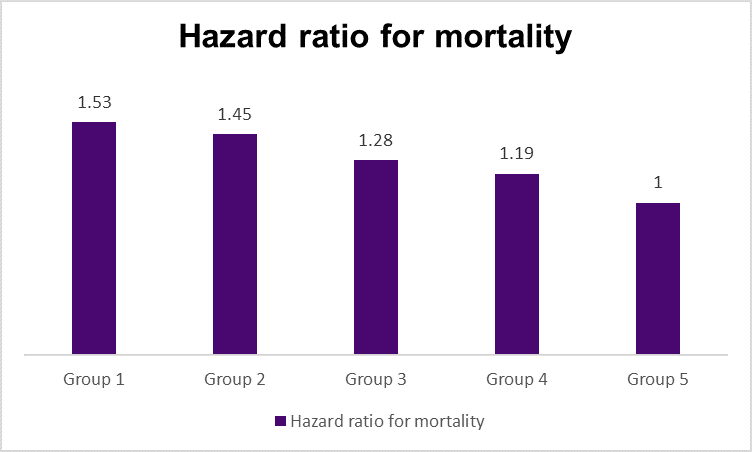Source: Goel, JAMA Network Open April 18, 2024 LINK. Group 1 is those who live in the lowest socioeconomic census tracts; group 5 is those who live in census tracts with highest socioeconomic status.
Those who live in the 20% of census tracts that are most socioeconomically disadvantaged are 53% more likely to die from their breast cancer and live on the average 7.7 months less than those who live in the 20% of census tracts that are most advantaged. Researchers combed through data from the Surveillance, Epidemiology and End Result database of over 350,000 diagnosed with breast cancer from 2013 to 2018, and published these results in JAMA Network Open.
Those in disadvantaged census tracts were more likely to have regional and distant spread of their cancer, more likely to receive chemotherapy, and less likely to have curative surgical therapy. Likelihood of dying during the study period was statistically significantly higher in the socioeconomically disadvantaged census tracts even after adjusting for insurance status, disease stage and other factors. Black people with breast cancer were 16% more likely to die during the study period than White people regardless of whether they lived in disadvantaged census tracts.
Implications for employers:
This research highlights the importance of making breast cancer screening readily available to all employees and family members.
Employers can compare their breast cancer screening rates against national HEDIS rates, as well as ask their carrier for the best rates in their network. If there is opportunity for improvement, as the health plan to develop a plan to work toward improvement.
Many patients with newly diagnosed breast cancer will benefit from evaluations from a national comprehensive cancer center or an expert medical opinion to be sure they obtain the optimal care.
Employers can ask their carriers for reporting by race and ethnicity to evaluate disparities in care or outcomes. This generally requires sharing census information, although can be done by imputing race and ethnicity based on census tract.


“Employers can ask their carriers for reporting by race and ethnicity to evaluate disparities”. What will this accomplish? Employers will not solve this ‘problem’. In fact, vast majority of HR type personas are the least equipped to do so - their world view prevents them from seeing why this pattern exists in the first place.